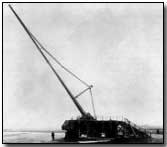Primary Documents - British Press Report on the Paris Gun, June 1918
 Reproduced below is a
British press account of the early use of the German Kaiser Wilhelm Geschutz
- better known as the
Paris Gun, in March 1918.
Reproduced below is a
British press account of the early use of the German Kaiser Wilhelm Geschutz
- better known as the
Paris Gun, in March 1918.
The press report, while recounting the dates and circumstances surrounding the firing of the enormous gun - capable of firing shells into the stratosphere from locations as far as 131km from Paris - nevertheless dismissed its military significance as negligible.
The Paris Gun was more of a propaganda weapon used by the Germans at home, and inflicted relatively little actual damage to Paris; it's terror capability was initially much feared however. It was first fired on 21 March 1918 to coincide with the opening of the great German Spring Offensive.
Click here to read an account of an early destructive use of the gun written by the U.S. Ambassador to Paris, William G Sharp.
British Press Report on the German Use of the Paris Gun, June 1918
This date was marked by a new departure in warfare. Paris was startled by a heavy shell falling in the town at 7.30 a.m. It was followed by others at intervals of about 20 minutes for some few hours.
The effects of the bombardment were entirely without military importance, the only results being some destruction of property and the killing and wounding of a number of harmless citizens, including many women and children.
On the 24th, Palm Sunday, Paris was again shelled, and Good Friday was also singled out as an appropriate day for the work of destruction. On the latter date the churches of Paris would be filled with worshipers, and there would be a grand opportunity for repeating on land the brave deed achieved in sinking the Lusitania on the sea.
A church was struck, part of the roof blown in, with the result that 76 persons were killed and 90 wounded, of whom a large proportion were women and children. On March 30th the victims numbered 8 dead and 90 wounded, but with these two exceptions the casualties were limited to quite small numbers, rarely over one, for each shell fired.
At the beginning of May the bombardment ceased for a time.
It did not take long to discover where the guns were stationed, and within a few hours from the time the bombardment began it was located by French aviators behind the St. Gobain Forest, not far from La Fere. A few days later the positions of two others were ascertained.
All three gun emplacements were on the reverse slope of a wooded hill known as the Mont de Joie, between the Laon-La Fere railway and the Laon-La Fere road, where they were hidden by the trees. It was an outlying spur of the hill-mass of St. Gobain.
A line drawn from Fourdrain to Couvron and Aumencourt would run through the centre of the position of the three gun-pits arranged approximately in the form of an equilateral triangle, the apex of which pointed towards Paris. They were all well under the crest line.
Each instalment consisted of a concrete pit in the shape of a long and deep trench, to which a line of railway ran back to the Laon-La Fere railway line. At the front end of each a concrete platform was constructed on which the gun carriage rested.
This was carefully covered by branches of trees which, combined with the neighbouring wood, served to protect the position as much as was possible from view.
When a big gun was fired a number of 17 cm guns in its neighbourhood were simultaneously let off so as to cover the sound of the larger explosion, and whenever the French aviators were seen approaching, the anti-aircraft guns were brought into action and volumes of smoke also discharged to render observation difficult.
Except at the time of discharge the gun was not elevated, its long-chase being kept down to avoid detection. Accommodation for the gun crews was provided in a bomb-proof dugout, which was connected with the gun-pit by a deep trench.
The distance from the big guns to the French lines was about six miles; the French heavy guns were some two miles farther back. A range of eight miles is long for accurate practice, but on the fourth day (i.e., March 26th) a shell fell into one of the gun cuttings and rendered the gun useless.
It must be remembered that unless a shell dropped actually in the trench or on the gun it would not do much harm. Artillery fire and bombs from the air were continuously directed on the position.
It was not till May 3rd that a very clear atmosphere allowed continuous observation. It was then seen that only one gun was in action and the concentrated fire of the French heavy guns would appear to have silenced it. From that day forward no shell fell on Paris till May 27th, by which time the gun had been repaired.
Source: Source Records of the Great War, Vol. VI, ed. Charles F. Horne, National Alumni 1923
A 'scorched earth policy' was the practice of deliberately destroying crops, food supplies and other facilities to prevent an invading enemy from using them.
- Did you know?
